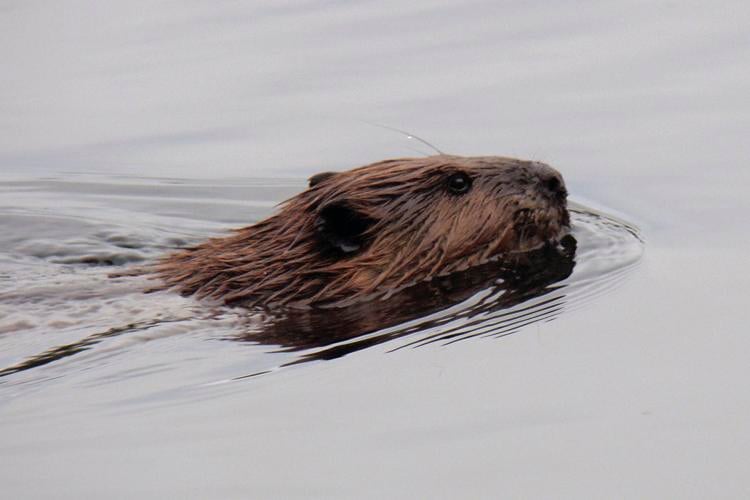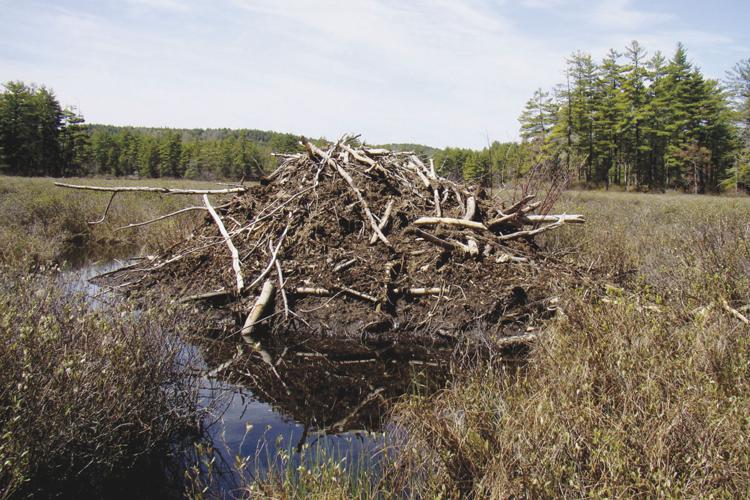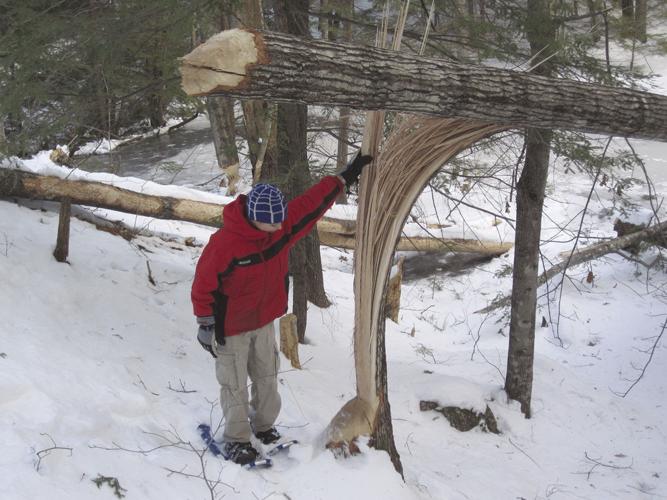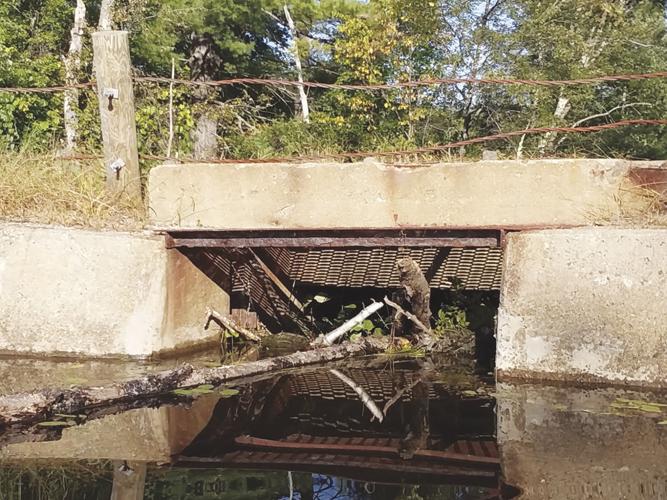The beaver is regularly labeled a busy, industrious animal, and that reputation is well deserved with the results of their efforts being visible all over New Hampshire in their lodges and well-constructed dams. They build intricate, sturdy structures using logs and branches packed with mud, weeds, and other debris to make them strong and leak-free — they are the original engineers!
Beavers are our largest rodents, but they have evolved to live almost entirely in the water to gain protection from predators. A beaver lodge is built on the bottom of the lake but the living quarters are above the water level; the entrance being hidden below the surface discourages unwanted visitors.
They emerge from their lodges every spring after a long winter. The most likely time of day to see a beaver is in the early morning when they inspect their dams for any leaks that may have sprung, or late in evening just before dark when they head out in search of new food supplies. Each spring, parents will kick last year’s kits out of the lodge to make room for the new litter. This means there are lots of young, inexperienced beavers out roaming around, often needing to cross roads to find their own place to live, resulting in one of the leading causes of death: road kill.
If you do see a beaver it’s likely it saw you first and it got your attention when it slapped its large, flat tail on the water to express its displeasure with your presence, as well as to alert the other beavers of an intruder. The resulting crash of water is so loud it is startling — the first time I heard an alert I thought someone threw a huge boulder into the water.
Beavers are now common throughout New Hampshire, but that hasn’t always been the case. The American Beaver (Castor canadensis) played an important role in the economics of early America as their pelts were a valuable source of revenue for the fledgling country. Beaver pelts were in such demand that they were hunted until the very last one in the state was trapped and its pelt sent off to Europe in the late 1800s. Six beavers were reintroduced to New Hampshire in 1926 with another 48 released in 1940, and without predators — wolf and coyote populations had also been greatly reduced or eliminated — they quickly flourished. Today they have reached or exceeded the maximum carrying capacity for the state.
Hunting of beavers is again allowed and is an important aspect of their management; a population of any species with few predators can quickly grow to a biologically unhealthy level. If a beaver population grows unchecked they can also create flooding problems for land owners, highway crews, and dam owners. Many a dam manager has had to deal with a thick, tangled, smelly clog of branches, weeds and mud that beavers have stuffed in a dam to plug it up.
Beavers are the only animal other than humans that actively change the planet to suit their needs. When they need a place to live they dam up a stream to create a pond. If they have consumed all the trees around their present beaver pond they might increase the size of their dam to expand the pond and make more trees readily accessible. When they have completely depleted the food supply (or if they’ve been banished from their parent’s pond) they will head out to find another stream to dam up and create a new pond. The evacuated pond will eventually dry up and return to meadow and eventually forest. If you see a large stand of dead trees in the middle of a flat meadow, it’s a good bet that’s an old beaver pond.
The size of a tree that a beaver can cut down with just its teeth is truly remarkable — I’ve seen red oak trees 18 inches in diameter felled. They are even smart enough to know that if they cut down trees they don’t like it will make space for their preferred trees to grow.
Beavers are important in the lives of many other animals due to the wetlands they create — dozens of amphibians, reptiles, and fish depend on beaver ponds for food and shelter, as do many species of birds. Heron and osprey built their nests in trees that died when the water flooded their roots. Having a home in the middle of a pond provides an extra level of protection for them as well as a ready supply of food.
You can find signs of beavers throughout the state — almost any small to medium body of water is likely to have a family living there. But one certain spot to see beaver signs in the Lakes Region is at the Page Pond Community Forest in Meredith. The Beaver Pond Trail of course leads to a large beaver pond, and the Page Pond Trail passes along another beaver pond and includes a bog bridge that runs right alongside an 80-foot beaver dam which provides a great opportunity to observe the intricately constructed dam with hardly a dribble of water leaking through. You can find more information and trail maps at the Meredith Conservation Commission website. Just bring your bug spray on those early morning and late evening beaver excursions!
•••
Scott Powell lives in Meredith, visiting the forest and waters in the Lakes Region and the White Mountains. He is a Conservation Commissioner for the town of Meredith, on the board of directors of the Lake Wicwas Association, and a member of the Land Stewardship Committee at the Lakes Region Conservation Trust. He writes a weekly journal about nature in the Lakes Region at https://wicwaslake.blogspot.com/ You can contact him at scottpowellnh1@gmail.com.






















(0) comments
Welcome to the discussion.
Log In
Keep it Clean. Please avoid obscene, vulgar, lewd, racist or sexually-oriented language.
PLEASE TURN OFF YOUR CAPS LOCK.
Don't Threaten. Threats of harming another person will not be tolerated.
Be Truthful. Don't knowingly lie about anyone or anything.
Be Nice. No racism, sexism or any sort of -ism that is degrading to another person.
Be Proactive. Use the 'Report' link on each comment to let us know of abusive posts.
Share with Us. We'd love to hear eyewitness accounts, the history behind an article.